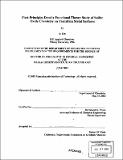First-principles density functional theory study of sulfur oxide chemistry on transition metal surfaces
Author(s)
Lin, Xi, 1973-
DownloadFull printable version (8.976Mb)
Alternative title
1st-principles density functional theory study of sulfur oxide chemistry on transition metal surfaces
Other Contributors
Massachusetts Institute of Technology. Dept. of Chemistry.
Advisor
Bernhardt L. Trout.
Terms of use
Metadata
Show full item recordAbstract
In this thesis, the chemistry of sulfur oxides on transition metals is studied extensively via first-principles density functional theory (DFT) computations, focusing on the chemical reactivity and selectivity in sulfur poisoning chemical processes that address environmental concerns. The systematic approach we establish can be extended to general computational studies of small gas-phase molecules interacting with extended surfaces or finite-size clusters. The thesis starts with a theoretical presentation of modem quantum many-body theory that brings together mean-field theory, DFT, and Green's function quantum Monte Carlo theory. The essence of chemical reactivity theory in the framework of DFT is emphasized. The thesis continues with an extensive survey of the current status of sulfur oxide chemistry and an overall presentation of our computational approaches towards a detailed understanding of chemical reactivity and selectivity. The basic guidelines in chemical reactivity are systematically constructed by computed comprehensive thermodynamic data of surface S, O, SO, SO2, SO3, and S04 species as a function of coverage at low and intermediate temperatures. Under these basic guidelines, experimentally measured surface spectra are interpreted, contradictory experimental observations are resolved, and applicable experimental measurements are suggested for confirming computational predictions. Moreover, the chemical reactivity study is supplemented by our chemical kinetics study focusing on the catalytic oxidation of SO2 under oxygen rich conditions. This is the key process that hampers the implementation of the next-generation automotive catalytic converter. The revealed Langmuir-Hinshelwood mechanism demonstrates the essential catalytic performance of the Pt(1 11) surface. (cont.) The thesis closes with a chemical selectivity analysis of the effects of catalyst particle size on chemisorption of gas-phase adatoms. In summary, the presentation of the chemistry of sulfur-containing molecules in this work is aimed at a scientific understanding of the strong poisoning effects in heterogeneous catalysis. However, the chemistry of sulfur-containing molecules has many more fundamental implications, such as in designing novel re-conjugated conducting devices for quantum computers. The underlying hybrid bonding flexibility of sulfur allows it to simultaneously bind to heavy transition metal atoms (such as Pt, Cu, or Au) and first-row atoms (such as oxygen atoms or carbon atoms in organic molecules).
Description
Thesis (Ph. D.)--Massachusetts Institute of Technology, Dept. of Chemistry, 2003. Vita. Includes bibliographical references (p. 297-309).
Date issued
2003Department
Massachusetts Institute of Technology. Department of ChemistryPublisher
Massachusetts Institute of Technology
Keywords
Chemistry.